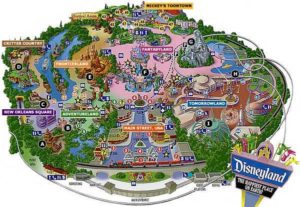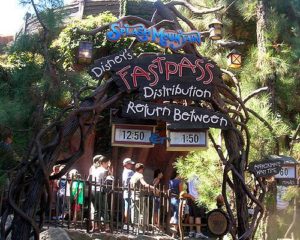Abstract
Disney uses fundamental industrial and systems engineering principles to create the optimal environment for maximum customer satisfaction in their amusement parks. By embedding efficient processes in their park layout such as the line design, FastPass system, and the Magic Band, Disney has seemingly made mundane processes magical. Disney pushes the envelope of innovation, shaping the future of theme parks.
Introduction
The mere thought of Disneyland brings smiles to millions of faces worldwide, and visiting the Happiest Place on Earth excites people of all ages. It is hard to have a bad day when stepping into a world of favorite childhood characters, movie scenes, and engaging shows in an interactive and theatrical environment. Since its opening in 1955, Disneyland has become the second most visited theme park in the world, right behind the Magic Kingdom at Walt Disney World [1]. However, this enormous and increasing popularity poses the problem of larger crowds and longer lines. Improving crowd control and line efficiency have been of the utmost importance in maintaining high customer satisfaction, return rate, and ultimately the magical Disney experience. Disney has seemingly contradictory goals, to both maximize the number of visitors, and therefore the profits, and also maximize the number of park guests who leave with a satisfied smile on their faces. With the efforts of industrial and systems engineers who specialize in process efficiency, Disney has mastered the art of optimization. Furthermore, waiting in line and navigating through crowds has been transformed from a tedious task to an enjoyable part of the park experience, ensuring the Disney magic continues.
Park Layout and Design
The Disney magic begins with a purposeful park layout and design. Park designers have creatively maximized their use of 85 acres of space to efficiently move crowds while keeping traffic to a minimum. Disneyland, as with all Disney parks, is divided into themed, iconic “lands,” each with a big, signature attraction that specifically attracts visitors to the land. For example, Frontierland has Big Thunder Mountain, Tomorrowland contains Space Mountain, and Adventureland houses the Indiana Jones Adventure. Not only has separating these lands dispersed crowds into different areas of the park, but Disney has also placed larger attractions at the far end of their respective lands, driving park-goers to the furthest edge of each land to visit the popular attractions, further drawing traffic away from the would-be congested center of the park. In addition to the dispersed design of the park, the iconic Main Street has a design that allows for smooth traffic flow into and out of the park. Upon entrance to the park, attendees are drawn down Main Street and toward Cinderella’s Castle, a visual landmark which brings park-goers into the center of the park and away from entrance gates. This prevents people from crowding near the entrances, which would create unhappy customers immediately upon their arrival.
Disneyland, like many other theme parks, has a “loop” design as shown in Figure 1, which leads park goers from land to land and ultimately creates less congestion at the park center [2]. The loop design is also convenient for traffic flow during parade and firework shows in which all park guests are directed to walk in a counterclockwise direction for single flow traffic during busy times. Ultimately, the combination of these intelligent designs creates a functional park that decreases congestion in an efficient and consistent manner, resulting in higher customer satisfaction.
Figure 1: Displays the general loop design as well as the division of the park into lands. http://disney.wikia.com/wiki/Disneyland_Maps_Gallery
Engineering of Line Design and Ride Capacity
How quickly does a ride need to run to get through a 300 person line in 15 minutes? Is the duration of the ride long enough to be enjoyable for people who have been waiting an hour or more? Where is the best placement of a line so that it does not interfere with main walkways and paths to other attractions? These are only a few questions pondered by the engineers at Disney. In fact, there is a whole field of psychology devoted to the emotion of queuing and how to decrease the boredom or uneasy feeling of waiting in line [3]. Of course, some wait is inevitable, but Disney specializes in lines that optimize the waiting time and distract visitors from the tiring queue with visual and interactive attractions, making the wait seem to go by much faster. But sometimes interactive line experiences can slow down the line if they are too much of a distraction to keep the line moving in a steady fashion. Thus, Disney has found a balance by introducing enough visual stimuli to be interesting, but not so much to slow the line down. Additionally, lines at Disney tend to work in a winding fashion so that the line appears shorter, and that the ride loading section appears to be getting closer [3]. The combination of the serpentine queue optical illusion with something to look at around every turn creates a more pleasurable environment for attendees.
In addition to the visual tricks Disney uses, the relationship between line design and ride capacity is also a vital component for customer satisfaction, as ride capacity affects how quickly a line moves. Each ride holds a different number of people and has a different run time, which affects how quickly or slowly the line progresses. For example, Haunted Mansion has a high ride capacity because the ride does not stop for passengers to get on but rather has a continuous conveyor belt in which there is no downtime. Downtime takes place when there is a lull in value added time to the ride and most commonly occurs when people are loading and unloading a ride [4]. A lessened downtime creates a smoother inflow and outflow of riders on the ride.
The Disneyland Haunted Mansion exemplifies maximizing ride capacity as it has the potential to entertain 2,618 guests per hour with 131 vehicles [5]. Of course, capacity is not always reached because every seat may not be filled on the ride. Optimal ride use would ensure that every seat is filled on every attraction vessel, allowing more people to experience the ride in a shorter amount of time, thus, Disney’s use of the Single Rider Line. The Single Rider Line moves at a faster pace than the standby line and increases the number of occupants on an attraction vessel by filling in empty seats. This is enjoyed by park attendees who choose to ride by themselves in exchange for more rides in a shorter amount of time.
FastPasses
In addition to the line design itself, FastPasses have become a main method for maximizing the time park attendees spend on attractions by minimizing the time they wait in line. FastPasses are a virtual queuing system that came to fruition at Disneyland in 1999 and have changed the way park attendees wait in line for attractions. For those who have attended any Disney park, they have likely witnessed the parent of a family gather up all of the park tickets and bolt to the FastPass kiosk as the rest of the family waits in line for the next attraction. As shown in Figure 2, the most popular rides have FastPass lines, which use the kiosks located outside the attraction. By inserting their admission tickets into the kiosk, a limited number of park-goers can receive a FastPass ticket with a window Return Time. During the specified Return Time, the FastPass ticket holder enters into the FastPass lane with a shorter wait time than the normal, standby line for the attraction [6].
Figure 2: The Disneyland Splash Mountain FastPass kiosk.
https://www.flickr.com/photos/23879054@N00/3108959047
This innovation has not only revolutionized the attendee’s time in the park, but has also optimized the ride usage from a systems engineering standpoint. FastPasses allow Disney employees to better understand how many people will be on a ride at a given time. The FastPass ensures an inflow of a certain number of people at the given Return Time interval, guaranteeing that the ride will be functioning at a high volume at an otherwise possibly low volume hour. By using this knowledge of where people will be and when, Disney can adjust locations of ride workers to best fit the volume of people attending certain rides [7]. It is important to note that this FastPass system does not increase or decrease the actual capacity of the ride because the ride does not go faster or more people do not get through, as with the Single Rider Line. Rather, the FastPass system optimizes user time and allows employee effort to be distributed based on the knowledge of ride crowds, increasing the opportunity to improve the park attendee’s experience.
The MagicBand
After the FastPass’s proven success, Disney once again used engineering innovation to further improve upon the FastPass idea and expand into other realms that boost attendee satisfaction. The MagicBand, as shown in Figure 3, is a personalized wristband for each park attendee at Walt Disney World Resort in Orlando, Florida. The value of the MagicBand technology begins with a park-goer purchasing a park ticket online, entering their park preferences, and receiving a personal itinerary generated by the Disney website. This itinerary is then hard-coded into the visitor’s personalized bracelet along with digital FastPasses to rides booked in advance, eliminating the time spent searching out the attraction to obtain a physical FastPass ticket [8].
Figure 3: The MagicBand with Radio Frequency technology [8].
The band uses Radio Frequency technology with short and long-range waves to detect the wearer’s location and give the individual a more personalized Disney experience [9]. The MagicBand sensors and systems communicate with each other to report exactly where crowds are forming in the park, and therefore where to send employees to fix a problem or assist park guests, overall optimizing employee effort and efficiency. Additionally, the MagicBand can function as a credit card and hotel room key if staying at Disney property. This removes the time guests would waste thumbing through their wallets, purses, and pockets, allowing park-goers to spend more time experiencing Disney World.
Conclusion
Disney’s constant drive to improve customer satisfaction is supported by fundamental engineering principles that are often applied in creative ways that are invisible to park guests. The general layout of the park, line design, and ride capacity solutions have created a smooth and efficient manner for guests to explore the park and maximize their time. In addition, the FastPass system and the MagicBand have revolutionized the way park attendees experience the theme park altogether. Disney has been at the forefront of innovating ways to improve park profit and customer satisfaction, continually shaping the future of theme parks.
References
[1] WorldAtlas. (2016, August 2). Most Popular Theme Parks By Attendance [Online]. Available: http://www.worldatlas.com/articles/most-popular-theme-parks-in-the-world.html
[2] P. Alexander. (2003) Park Layout [Online]. Available: http://www.themedattraction.com/
[3] V. Woods. (2013, September 18) Why Lines for Disney Rides are ‘Magic’ [Online]. Available: http://www.livescience.com/39764-mastering-the-psychology-of-standing-in-line.html
[4] R. Niles. (2013, April 10) Theme Park Tech: The queue’s blues [Online]. Available: http://www.themeparkinsider.com/flume/201304/3441/
[5] D. Bertino. (1996, October 31) Disney’s Haunted Mansion Frequently Asked Questions [Online]. Available: http://www.faqs.org/faqs/disney-faq/haunted-mansion/
[6] Disney Geek. FastPass at Disneyland Resort [Online]. Available: https://disneygeek.com/disneyland/other/other_fastpass.php
[7] Plexxi. (2013, June 12) Disney’s Fast Pass Program – Datacenter Style [Online]. Available: http://www.plexxi.com/2013/06/disneys-fast-program-datacenter-style/
[8] C. Kuang. (2015, March 10) Disney’s $1 Billion Bet on a Magical Wristband [Online]. Available: https://www.wired.com/2015/03/disney-magicband/
[9] Disney. Unlock the Magic with Your MagicBand or Card [Online]. Available: https://disneyworld.disney.go.com/plan/my-disney-experience/bands-cards/







